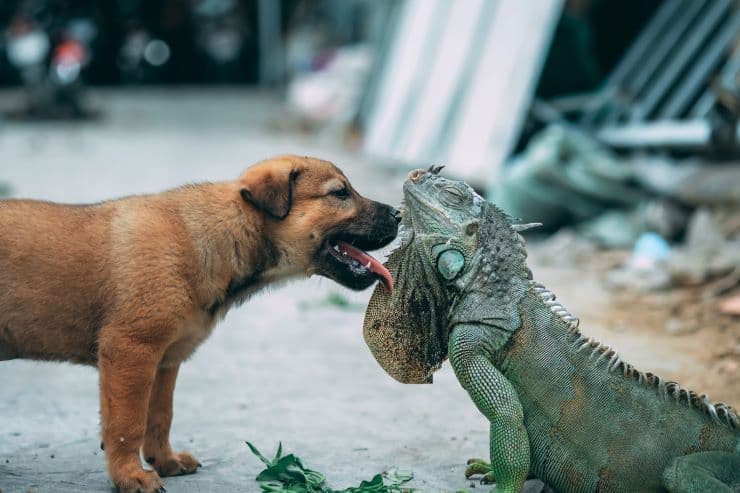Did you know that most pet lizards are amazing reptiles full of spunk and personality? Bearded dragons, for example, enjoy being handled and scratched on the chin. There are so many interesting things to learn about these delicate but amusing pet lizards, including how to bathe them and how to trim their nails, over at reptileslife.com.
But what if you’re keeping both a dog and a lizard as pets?
By Jennifer Munsell
One day, your dogs may simply be chasing a lizard in the garden, bite into it, and end up enjoying the taste. Before you know it, your pups are sneaking out and dining on lizards when you’re not looking.

Photo Credit: Suong Nguyen on Unsplash
They could eat a few lizards without showing any signs of toxicity. But you’ll never know when your dogs will come across poisonous lizards or lizards that are infected with salmonella. Not a good scenario at all. So, you have no option but to know how to prevent your dogs from eating lizards.
Let’s go over some important essential tips and tricks that can help stop your dogs’ cravings for these reptiles.
Tips and Tricks to Consider
Our recommendations are not difficult to implement but you have to put in some time and effort to help stop your dogs’ new eating habits.
The following are some of the top things you can do.
Keep Your Pet Lizard Out of Reach
The chances of your dog eating a lizard are likely to increase if you have a pet lizard at home. So, create or buy a pet lizard enclosure.

Photo Credit: Enes Aktas on Unsplash
An enclosure does more than just provide a safe room for your little reptile when you aren’t around. It provides the lizard with a secure basking environment, food, and water. You can also use the enclosure to create a physical barrier between your dog and your pet lizard. The cage should be comfortable enough for your reptile.
Keep Wild Lizards Away from Your Home
Teaching your dog the leave-it command may not be enough when it is off-leash within the compound of your home and the place is crawling with wild lizards. The constant presence of garden lizards from the nearby bush may be too overwhelming for your dog to ignore, especially when you are not looking.
So, you have no choice but to keep lizards away. The following are some of the things you can do to fend them off.
Lizard Repellents
Simple repellents can prove to be very effective at chasing away wild lizards. You can use either commercial or homemade lizard repellents.
Some very effective household repellents you can consider are mint leaves, black pepper, cayenne pepper, mothballs, coffee grounds, and garlic. Apply these products to areas where you want to restrict lizard presence.
Commercial products you can consider include lizard blockers, lizard defense, and natural armor. You can procure these products from garden shops.
Keep Your Home Clean and Close Any Entry Points
Always keep your shed, garage, and home clean to avoid attracting small lizards, such as geckos. Make sure there are no tiny openings around your windows and doors to prevent the entry of wild small lizards. The kitchen is normally the prime target for most wild lizards because of vegetables, fruits, and insects.
Keep the Lawn Properly Maintained
Regular lawn maintenance is a must if you want to keep wild lizards away from your dogs. There shouldn’t be excess clutter, poor drainage, or overgrown weeds because these are ideal shelters for many wild lizard breeds. In addition, keep the yard clean and neat at all times.
Teach Your Dog and Pet Lizard to Co-Exist

Photo Credit: Chewy on Unsplash
We all know that dogs can learn commands, such as the leave-it command or the ok-to-eat command. So, it shouldn’t be that difficult to help your dog share the home environment with your lizard. Did you know that your lizard can also learn how to co-exist with a pet of different species?
The first thing you’ve got to do is introduce the lizard to the canine. The two animals have to sniff each other and get used to the scent of one another. It’s best to do the introduction in a neutral part of the house where these two animals rarely go.
Start the introduction by exposing your dog to the pet lizard enclosure. Closely watch the reactions of your dog. The pup will most likely sniff the enclosure, which is normal. But reprimand it if it whines or barks continuously at the tank. This exercise will help the dog get used to the lizard’s scent. Once the dog stops barking, you will know that it has gotten used to the reptile’s scent.
The next step would be to bring the two animals together. But before you do that, take the lizard and the dog to the vet for a check-up. You have to ensure that your lizard is free of salmonella or liver fluke. Once the vet concludes that the two pets are healthy, you can go ahead with the physical interactions.
Slowly bring the pet lizard and dog near each other. Preferably, you should have someone else watching the lizard, while you are watching the dog on a leash. Let your dog sniff the lizard and pat it gently for positive reinforcement.
You should end the interaction if you see any signs of aggression from either animal. Signs of aggression for a dog are fur prickling, barking, or growling. As for the lizard, watch out for tail raising, head shaking, head bobbing, push-ups, and tail whipping.
Plan more interactions and meetings until the two animals no longer show signs of aggression. The process of helping these pets coexist could take slightly longer than you had imagined. Just don’t make the mistake of leaving them together unsupervised.
Teach the ‘Leave It’ Command
Dogs, such as the Black Russian Terrier and East-European Shepherd can easily learn the ‘leave it’ command. This is an important prevention technique if your home is located in a lizard-friendly environment, such as near a wooded area.
Initial Training
To teach your dog this trick, start by making your ‘leave-it’ treat a very low value. Usually, something that your furry pal will not be interested in. Place the low-value treat in your left hand and your dog’s favorite treat (yummy kibble or cheese) in your right hand.
Start by holding a treat at your dog’s nose level in an open hand. If your dog tries to eat the treat, close your hand into a fist and hold it still. Let the dog lick your closed hand even though it is closed. Wait for your pup to ignore your closed hand by looking away from it, backing away from it, or looking at you. Reward your pup right away with your other hand.
As you continue with the leave-it command training, your dog will start to ignore your hands much more quicker. When it has mastered the game, switch hands by putting your low-value treat in your other hand. Then, reward it with a high-value treat from your right hand.
Add the Command
When it can ignore the treat even though your hand stays open, then it’s time to introduce your command.
You can say 'leave it' as you open your hand and be ready to close your hand if the dog suddenly gets tempted to eat the treat. When your dog can effortlessly ignore a treat—whether high-value or low-value—on either hand when opened, then you are ready to start putting the treat on the ground.
The first time you put a treat on the ground, your pup might be a little bit confused. So, you should be ready to cover the treat with your foot and wait for the dog to raise its head and look at you. When it looks up at you, be ready to reward it with a high-value treat.
You will know you are ready to use the ‘leave it’ command again if your pup successfully ignores the treat on the ground without you covering it with your foot.
Put your dog to test once it learns the ‘leave it’ command. Expose it to a bright toy lizard and use the command. If the dog complies, then your prevention technique is successful.
Rumble Video: Lizard Defends Itself from Dogs
FAQs
Can my dog die if it eats a lizard?
Wild lizards could be poisonous or carriers of bacteria and parasites. So, your dog is highly likely to get poisoned or infected by salmonella and could become sick.
What happens if my dog ingests a gecko?
This small lizard breed is usually not poisonous, but it could be a carrier of salmonella bacteria. It could also upset the stomach of your dog or even cause a blockage.
Can my dog become sick by licking a lizard?
It depends on whether or not the lizard is infected with the salmonella bacteria. That’s why it is important to have your pet lizard checked by the vet before introducing it to your dog.
About the Author

When Jennifer was seven years old, she begged and pleaded for a cute fluffy puppy. She got a lizard instead to start with 'something smaller'.
She named him Pascale and he became the sidekick to her Rapunzel as she drew and colored. Time went by, and Jennifer asked for a chameleon, then for an iguana, and before she knew it, reptiles have become a fixture in her life.
Today, Jennifer Munsell shares her knowledge and great personal experience at her popular blog ReptilesLife (don't forget to visit it!)
P.S. Jennifer is a reptile lover but she loves dogs too!
Also View: What Vegetables Can Bearded Dragons Eat? (Correct Diet)

Leave a Reply